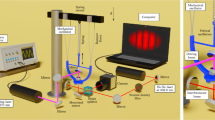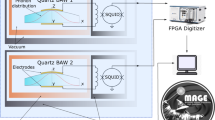Abstract
THE accuracy of the unperturbed frequency of the hydrogen maser is limited by the uncertainty of the wall shift caused by the storage bulb coating1. Different samples of nominally the same material have been found to give different shifts2 and so it seems that a frequency determination should include an independent measurement of wall shift. The results of such determinations3–7, however, have a spread of 0.018 Hz which is large compared with the potential accuracy of the maser. The wall shift depends on the number of bounces of the atoms on the wall of the bulb and for a spherical bulb can be expressed as K/D where K is a constant for a particular coating material and D is the diameter of the bulb. If measurements are made with bulbs of different size and the frequency is plotted against I/D), the true frequency is that corresponding to infinite bulb size, that is 1/D = 0, and the slope of the line gives the constant K. The range of bulb sizes that can be used is limited by practical considerations and there is therefore an extrapolation error in addition to the error of measurement. This extrapolation error can be reduced by making measurements with two different coating materials and making the assumption that the values should coincide at 1/D = 0.
This is a preview of subscription content, access via your institution
Access options
Subscribe to this journal
Receive 51 print issues and online access
$199.00 per year
only $3.90 per issue
Buy this article
- Purchase on Springer Link
- Instant access to full article PDF
Prices may be subject to local taxes which are calculated during checkout
Similar content being viewed by others
References
Ramsey, N. F., Amer. Scientist, 56, No. 4, 420 (1968).
Zitzewitz, P. W., Uzgiris, E. E., and Ramsey, N. F., Rev. Sci. Instrum., 41, No. 1, 81 (1970).
Crampton, S. B., Kleppner, D., and Ramsey, N. F., Phys. Rev. Lett., 11, 338 (1963).
Vanier, J., Peters, H. E., and Vessot, R. F. C., IEEE Trans. Instrum. and Meas., IM- 13, 185 (1964).
Vessot, R., Peters, H., Vanier, J., Beehler, R., Halford, D., Harrach, R., Allan, D., Glaze, D., Snider, C., Barnes, J., Cutler, L., and Bodily, L., IEEE Trans. Instrum. and Meas., IM- 15, 165 (1966).
Menoud, Ch., and Racine, J., Colloque International de Chrono-métrie, Paris, September A8–1 (1969).
Hellwig, H., Allan, D. W., Glaze, D. J., Vessot, R. F. C., Levine, M., Zitzewitz, P. W., and Peters, H. E., Conference on Precision Electromagnetic Measurements, IEEE, 72 (1970).
Bender, P., Phys. Rev., 132, 2154 (1963).
Vanier, J., and Vessot, R. F. C., Appl. Phys. Lett., 4, 122 (1964).
Crampton, S. B., Phys. Rev., 158, 57 (1967).
Becker, G., and Fischer, B., PTB-Mitteilungen, 78, 177 (1968).
Author information
Authors and Affiliations
Rights and permissions
About this article
Cite this article
ESSEN, L., DONALDSON, R., BANGHAM, M. et al. Frequency of the Hydrogen Maser. Nature 229, 110–111 (1971). https://doi.org/10.1038/229110a0
Received:
Issue Date:
DOI: https://doi.org/10.1038/229110a0
This article is cited by
-
Magnetic configuration effects on the Wendelstein 7-X stellarator
Nature Physics (2018)
-
In-beam measurement of the hydrogen hyperfine splitting and prospects for antihydrogen spectroscopy
Nature Communications (2017)
-
Dirac equation, hydrogen atom spectrum and the Lamb shift in dynamical non-commutative spaces
Pramana (2017)
-
Gravitational radiation in dynamical noncommutative spaces
General Relativity and Gravitation (2017)
-
Magnetic-confinement fusion
Nature Physics (2016)
Comments
By submitting a comment you agree to abide by our Terms and Community Guidelines. If you find something abusive or that does not comply with our terms or guidelines please flag it as inappropriate.



